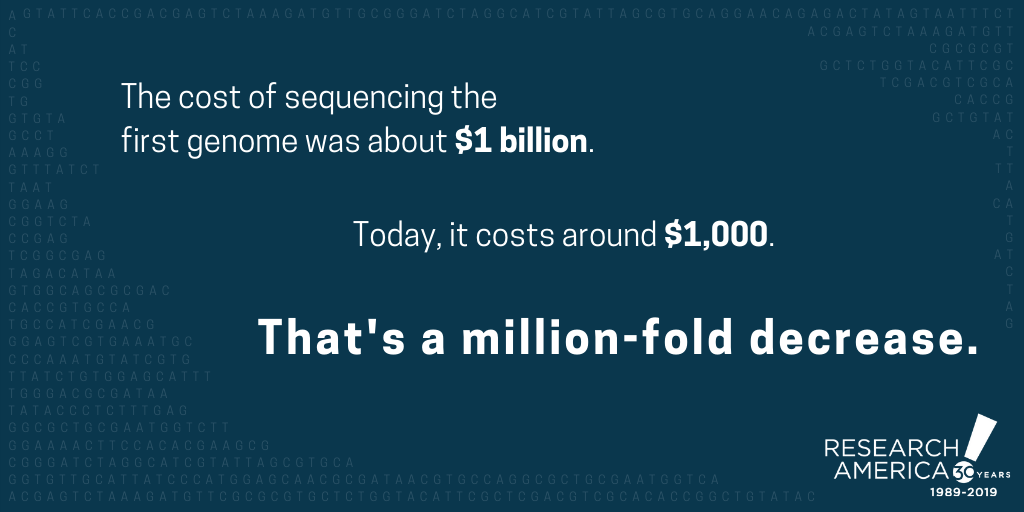Human Genome Project to Precision Medicine

“Sixteen years ago we had in front of us, for the first time ever, the order of the three billion letters that make up the human genome,” began Dr. Eric Green, Director of the National Human Genome Research Institute (NHGRI). Genetic sequencing and genomics have come a long way since 2003, when the Human Genome Project announced the completion of the first full sequence of the human genome. At the “Human Genome to Precision Medicine” briefing hosted by the Congressional Biomedical Research Caucus and the Coalition for the Life Sciences, Dr. Green discussed the triumphs, advances, and ongoing challenges unfolding around genomics.
The cost of sequencing that first genome was around $1 billion. As sequencing technology has advanced, that cost has decreased a million-fold.
 Today, it costs around $1,000 to sequence a genome, a leap that has had very tangible impacts on patients, scientists, and physicians. Genetic sequencing is now an accessible tool used for inquiry into a wide range of diseases. Complex conditions—like cancer and rare diseases—have particularly benefited from sequencing breakthroughs. Since “cancer is basically a disease of the genome,” explained Dr. Green, “the whole field of cancer research has been turned upside down, in a very good way, by genomics advances.” With the ability to easily sequence the genome of individual patients’ cancers, it is possible to find unique mutations driving the growth of cancer cells, and get a better idea of how to effectively treat them. Genomic advances have also fundamentally changed the outlook for rare diseases, many of which are rooted in a patient’s genetic code. When the Human Genome Project began, only 60 rare diseases had known causes. Now, we know what’s wrong in the genome for over 5,200 of these conditions, a critical first step towards unlocking potential therapies and cures.
Today, it costs around $1,000 to sequence a genome, a leap that has had very tangible impacts on patients, scientists, and physicians. Genetic sequencing is now an accessible tool used for inquiry into a wide range of diseases. Complex conditions—like cancer and rare diseases—have particularly benefited from sequencing breakthroughs. Since “cancer is basically a disease of the genome,” explained Dr. Green, “the whole field of cancer research has been turned upside down, in a very good way, by genomics advances.” With the ability to easily sequence the genome of individual patients’ cancers, it is possible to find unique mutations driving the growth of cancer cells, and get a better idea of how to effectively treat them. Genomic advances have also fundamentally changed the outlook for rare diseases, many of which are rooted in a patient’s genetic code. When the Human Genome Project began, only 60 rare diseases had known causes. Now, we know what’s wrong in the genome for over 5,200 of these conditions, a critical first step towards unlocking potential therapies and cures.
Breakthroughs in genomics aren’t only relevant for individuals suffering from cancer or rare diseases. After all, “almost all diseases have a genetic influence, if not a direct genetic cause,” explained Dr. Green. “The significant advances to come in the future will come more from common diseases.” Conditions such as hypertension, diabetes, and Alzheimer’s are influenced by a person’s genetics, as well as environmental and social determinants of health. New technologies outside the field of genomics are also improving our ability to evaluate external factors, paving the way for “precision medicine” that can account for both individual and systemic factors that can affect human health.
Advances in genomics have helped create a new field—pharmacogenomics—which examines how individual genetic differences affect how patients respond to medication. As pharmacogenomics progresses, physicians, armed with a patient’s genetic profile, will be better able to predict the medications their patients will respond well to. Modern genomic technology is changing the world of prenatal genetic testing, too. With technology that can detect very tiny amounts of fetal DNA in a pregnant person’s bloodstream, prenatal screening can occur without invasive procedures.
While it may now be easy to sequence someone’s genome, it’s hard to turn that raw data—those 3 billion pairs of As and Ts, Cs and Gs—into actual insight, to see where a misspelling—a C instead of a T, a deletion or insertion of letters or sequences—predicts an increased likelihood of a certain condition. Linking that data up with lifestyle, environmental, and social determinants of health is no small feat. According to Dr. Green, discovering how to utilize these various sources of data in tandem will likely require more researchers with computer science backgrounds, as well as more use of AI technologies.
There exist other, non-technological challenges that the field of genomics must also wrestle with. Most striking, perhaps, is that of diversity. “It’s an area where we have not been doing well,” said Dr. Green, “and we will be doing better.” This issue is exemplified by the profiles of genomics studies’ participants. In 2009, 96% of study participants were of European ancestry. By 2016, that number had decreased to 81%–but 78% of this change was due to increased representation of populations with Asian ancestry, leaving all other populations underrepresented.
Shifts in where genetic sequencing is done may magnify that problem. Whereas health care systems generated only 1% of new human genome sequences in 2012, Dr. Green expects that number to grow to over 80% by 2022. If health care is unevenly accessible, individuals from diverse but historically underserved communities may not be able to access genomic medicine and genetic sequencing. That’s an issue in and of itself, and also one that could potentially exacerbate the diversity problem in the collection of human genome sequences, with members from these populations continuing to be under-represented in genome databases.
Genetic sequencing locales are changing within the National Institutes of Health as well. Whereas NHGRI was once the sole home of genomics within the NIH, genomics research is now performed across the NIH’s institutes and centers. Dr. Green pointed out that “90% of all genomics research is being funded by other research institutes, not us.” It’s a testament to NHGRI’s success in getting genomics adopted across the biomedical research field. It also signifies a necessary shift in focus for NHGRI. “We’re no longer about all of genomics,” said Dr. Green, “we’re just about the forefront.”
This blog post was written by Sonya Sternlieb, a policy intern at Research!America. The policy internship is funded by the Burroughs Wellcome Fund.




